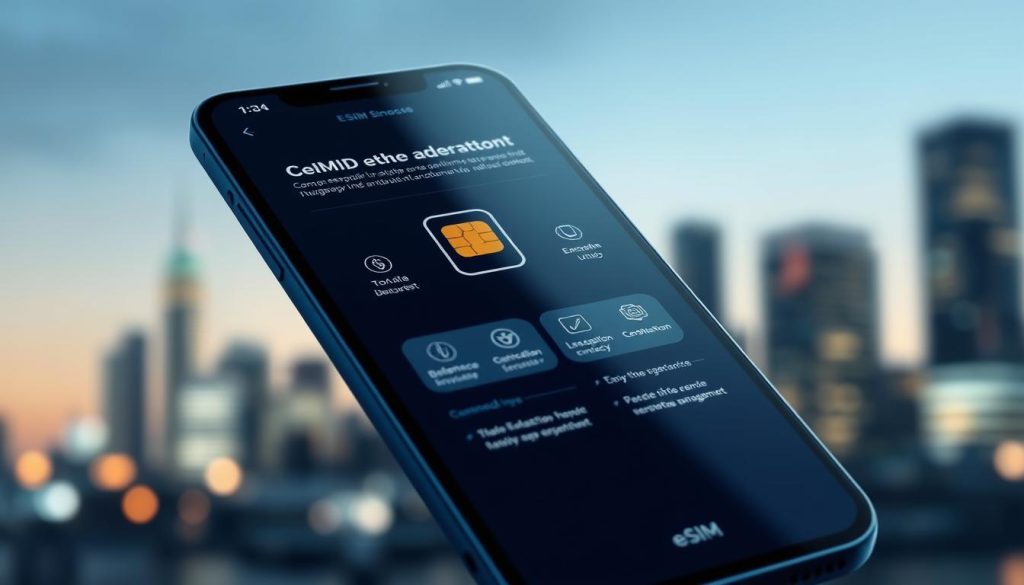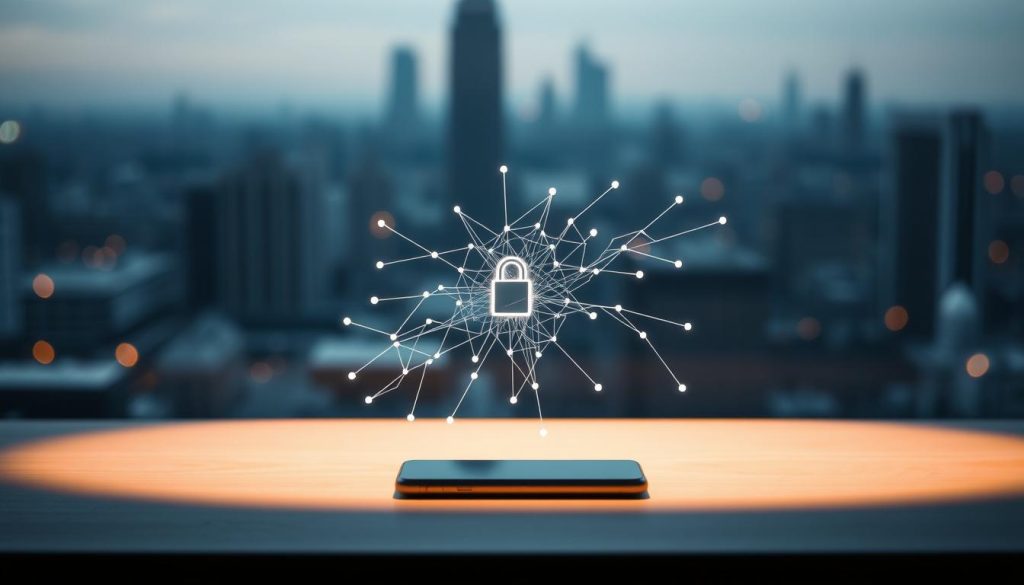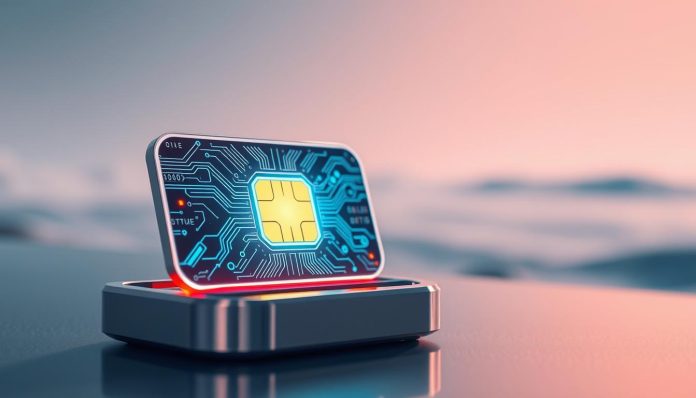As mobile technology advances, more people are using eSIMs. They are convenient and flexible. But, this change also brings up big questions about data protection and security.
Thinking about switching to eSIM technology? It’s key to know how it affects your personal data and privacy. eSIMs, or embedded SIMs, have many benefits. But, they also have unique privacy concerns you should be aware of.
It’s important to understand eSIM data protection and how to keep your privacy safe. This means knowing about your eSIM provider’s privacy policies and how to protect your data well.
Key Takeaways
- Understand the privacy implications of switching to eSIM technology.
- Learn about the benefits and risks associated with eSIMs.
- Discover how to enhance your eSIM data protection.
- Know what to look for in eSIM privacy policies.
- Be aware of the measures to protect your personal data with eSIM.
Understanding eSIM Technology
It’s important to know about eSIM technology to understand its privacy impact. An eSIM, or embedded SIM, lets you start a cellular plan without a physical SIM card. It’s found in devices like smartphones and tablets, making it easy to switch carriers.
eSIMs can hold many carrier profiles at once. This is great for travelers or those with work and personal calls. The flexibility and convenience of eSIMs are big pluses, but they also raise privacy and security concerns.
eSIMs and traditional SIMs differ in how they store carrier info. Traditional SIMs use a physical card, while eSIMs use digital storage. This digital storage makes us wonder about data protection and who can access it. The security of eSIM technology is a big deal for user privacy.
Key Features of eSIM Technology
- Digital SIM integration into devices
- Ability to store multiple carrier profiles
- Ease of switching between carriers and plans
- Enhanced flexibility for users
To understand eSIMs better, let’s compare them to traditional SIMs:
| Feature | eSIM | Traditional SIM |
|---|---|---|
| SIM Type | Digital | Physical |
| Carrier Switching | Easy, digital switching | Requires physical swap |
| Storage | Digital storage on device | Physical SIM card |
In summary, eSIM technology brings many benefits like flexibility and ease. But, we must think about privacy and security. Knowing these points will help you choose the right cellular plan and protect your digital identity.
Benefits of Using eSIMs
eSIM technology is changing how we handle our mobile plans. It lets you switch carriers and plans easily, without swapping SIM cards. This is great for travelers or those with multiple devices.
One big plus of eSIMs is storing multiple profiles on one device. This makes managing different numbers or plans easy. Plus, it helps the environment by cutting down on SIM card waste.
When it comes to eSIM switch privacy, eSIMs are secure. Switching profiles is simple and safe, keeping your data protected.

For eSIM user data privacy, eSIMs use strong security. They use encryption and secure protocols to keep your data safe from hackers.
Here’s a quick look at the main benefits of eSIMs:
| Benefit | Description | Advantage |
|---|---|---|
| Flexibility | Easy switching between carriers and plans | Simplifies mobile plan management |
| Convenience | Multiple profiles on a single device | Enhances user experience |
| Sustainability | Reduces physical waste by eliminating SIM cards | Environmentally friendly |
Using eSIMs means a more convenient, secure, and eco-friendly mobile life.
Privacy Risks Associated with eSIMs
Thinking about switching to eSIM technology? It’s important to know the privacy risks. eSIMs store your carrier info digitally, which could lead to data breaches.
eSIMs might let carriers or others track you, which could harm your privacy. Knowing these risks helps you protect your privacy better.

One big worry with eSIMs is data breaches. Since they’re in your device, unauthorized access to your info is possible.
Key Privacy Risks
- Data breaches: Unauthorized access to your carrier info and other sensitive data.
- Tracking: Carriers or third parties might watch your activities.
- Lack of control: You might not have much say in how your data is used and shared.
Let’s look at how eSIMs compare to traditional SIM cards in terms of privacy.
| Feature | Traditional SIM | eSIM |
|---|---|---|
| Data Storage | Physical storage, less susceptible to digital breaches | Digital storage, risk of data breaches |
| Tracking | Less traceable due to physical nature | More traceable due to digital connectivity |
| Privacy Control | Easier to manage privacy by physically removing SIM | Requires digital management, potentially complex |
eSIMs have privacy risks, but they also have eSIM privacy features to help. Using these features is crucial for keeping your privacy safe.
By understanding the risks and managing your eSIM privacy, you can enjoy eSIM tech while keeping your info safe.
Comparing eSIM and Privacy Concerns
When thinking about eSIMs, it’s key to look at how they handle your personal data. eSIMs are more flexible and convenient than traditional SIMs. But, they also raise big privacy concerns.
Carriers are big players in eSIM data management. Their policies on user data can really affect your privacy. It’s important to compare how different carriers handle eSIM data and protect your privacy.
Key Differences in Privacy Concerns
| Feature | eSIM | Traditional SIM |
|---|---|---|
| Data Storage | eSIMs store data digitally, which can be more vulnerable to cyber threats. | Traditional SIMs store data physically, potentially offering more security against digital breaches. |
| Carrier Control | Carriers have significant control over eSIM data, which can impact user privacy. | Traditional SIMs offer users more control over their data, as it’s physically stored on the SIM card. |
| Security Measures | eSIMs often come with advanced security features, such as remote provisioning and encryption. | Traditional SIMs rely on physical security measures and may not offer the same level of encryption as eSIMs. |

When looking at eSIM privacy, it’s crucial to check the carrier’s policies and security measures. This helps you decide if eSIM technology fits your needs.
Choosing between an eSIM and a traditional SIM depends on your privacy and convenience needs. By weighing the pros and cons, you can pick the best option for you.
Steps to Enhance eSIM Privacy
To boost eSIM privacy, pick the right carrier and manage your eSIM profiles well. First, choose a carrier that values data protection. Look for carriers with strong privacy policies and data protection.
When picking a carrier, check their data security record and how they handle data. Read their privacy policies and look for third-party audits. For example, some carriers have ISO 27001, showing they manage data security well.

Managing your eSIM profiles is key. Learn how to add, remove, or modify profiles on your device. Regularly check your eSIM profiles to spot any risks.
Here’s a look at how different carriers protect eSIM data:
| Carrier | Data Protection Measures | Transparency |
|---|---|---|
| Carrier A | End-to-end encryption, regular security audits | Clear data handling practices, third-party audits |
| Carrier B | Data encryption, secure data storage | Transparent about data sharing practices |
| Carrier C | Basic data protection, limited transparency | Limited information about data handling practices |
By picking a carrier with good data protection and managing your eSIM profiles, you can improve your privacy. Keep an eye on your eSIM profiles and know how your carrier handles data to stay private.
Understanding Carrier Restrictions
It’s key to know the limits set by carriers for a smooth eSIM experience and to keep your privacy safe. Carriers have rules that can limit how you switch providers or use your device with other carriers.
When you buy a device with an eSIM, it usually only works with the carrier you bought it from. This lock stops you from switching to another carrier unless you meet certain conditions or pay a fee to unlock it.
Carrier Locking Mechanisms: Carriers use different locks to make sure their devices stay on their network.
| Carrier | eSIM Locking Policy | Switching Limitations |
|---|---|---|
| Carrier A | Locked for 30 days | Max 2 switches per year |
| Carrier B | Locked for 60 days | Max 1 switch per year |
| Carrier C | No lock | No limitations |
Knowing these carrier rules helps you make better choices about your eSIM use and keeps your privacy safe.
Using VPNs with eSIMs
Using a VPN with your eSIM is a smart move to protect your online data. When you use an eSIM, your data travels over the internet. This makes it vulnerable to various threats. A VPN encrypts your internet traffic, making it hard for others to get your data.
To keep your data safe, pick a VPN that values privacy and uses strong encryption. Look for VPNs that are open about their logging practices and protect user data well.
When picking a VPN, think about the number of servers, how fast it is, and if it works with your devices. Some VPNs also block malware and ads, adding extra security to your online activities.
Using a VPN with your eSIM greatly boosts your eSIM privacy control. This is especially true when using public Wi-Fi, which is often not secure and can be hacked.
In short, using a VPN with your eSIM is a great way to protect your data. By choosing a trusted VPN and being careful online, you can have a safer and more private mobile experience.
Regulatory Environment for eSIMs
Thinking about switching to an eSIM? It’s important to know about the rules that protect your privacy. The rules for eSIMs vary a lot from country to country. This affects how your data is kept safe.
Many laws control the use of eSIMs, and they change depending on where you are. In the United States, for example, the Federal Communications Commission (FCC) watches over eSIMs. Important rules cover privacy, data safety, and telecom laws.
- Data Protection Laws: Rules like the GDPR in Europe and the CCPA in the United States tell companies how to handle your personal info.
- Telecommunications Regulations: Telecom laws shape how carriers use and manage eSIMs.
- Consumer Rights: Knowing your rights as a user is key, especially when it comes to privacy and data safety.
To keep your privacy safe, do the following:
- Keep up with the laws in your area.
- Know your carrier’s eSIM privacy policies.
- Boost your eSIM privacy by using VPNs and being careful with your data.
Being informed about the rules and taking action can help protect your privacy with an eSIM. Your privacy is precious, and knowing the laws can help you make smart choices about using eSIMs.
What to Look for in eSIM Privacy Policies
Checking eSIM privacy policies is key to keeping your data safe. When thinking about switching to eSIM, it’s important to know how your info is handled and kept secure.
When looking at eSIM privacy policies, search for clearness about data use. Carriers should tell you how your data is used and give you ways to control your privacy. This means knowing what data is taken, how it’s stored, and if it’s shared with others.
Another important thing is data protection steps. Good eSIM providers use strong security to protect your info. This includes using encryption, keeping data in safe places, and checking security often.
To compare eSIM providers, here’s what to look for in their privacy policies:
| Feature | Description | Importance |
|---|---|---|
| Data Collection Transparency | Clear info on what data is taken and how it’s used. | High |
| Data Protection Measures | Strong security steps like encryption. | High |
| User Controls | Options for users to manage their privacy. | Medium |
| Data Sharing Practices | Info on if data is shared with others. | High |
By looking closely at these parts of eSIM privacy policies, you can choose the best provider for your eSIM security and eSIM data protection.
Real-World Implications of eSIM Privacy
eSIM privacy risks are a growing concern. Data breaches can have serious consequences for consumers. It’s important to understand these risks and protect your privacy when using eSIMs.
One big eSIM privacy concern is data breaches. If an eSIM is hacked, your phone number, location, and personal data can be stolen. This can lead to identity theft and financial fraud.
Looking at data breach cases involving eSIMs can help us understand the risks. For example, hackers found a weakness in a major carrier’s eSIM activation. They got access to customer data.
Key Statistics on eSIM Data Breaches
| Year | Number of Breaches | Records Affected |
|---|---|---|
| 2020 | 15 | 1.2 million |
| 2021 | 23 | 2.5 million |
| 2022 | 30 | 4 million |
The table shows more eSIM data breaches and affected records each year. This shows we need better privacy measures for eSIM users.
To lower eSIM privacy risks, follow security best practices. Use strong passwords, update your eSIM software, and be careful when activating it on new devices.
By understanding eSIM privacy risks and taking steps to protect yourself, you can enjoy eSIM technology safely. This way, you can use it without worrying about privacy issues.
Future Trends in eSIM Privacy
eSIM technology is getting better, and so is privacy. New security features will make eSIMs safer and more private. This means better protection for your data.
As more people use eSIMs, companies will focus on keeping your info safe. This is to keep your trust. Keep an eye on these changes to protect your privacy.
New tech like better encryption and stronger authentication will help. Knowing about these trends helps you use eSIMs wisely. It keeps your personal data safe.

